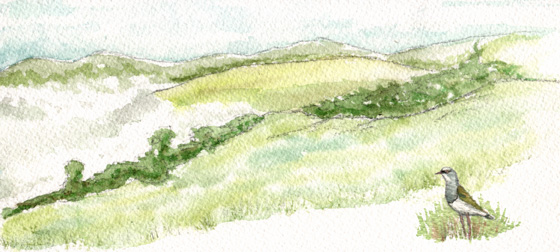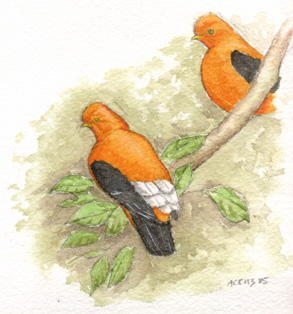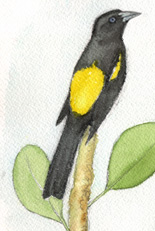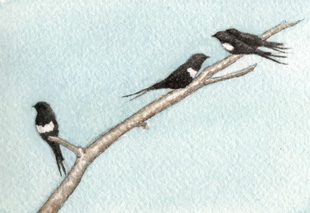Alex Cruz was born a "Newyorican" in Brooklyn, New York in 1968, but raised in the West. His educational background is in biology and science illustration. He currently lives in Crystal, Minnesota and works as a freelance graphic designer. "Drawing birds allows me to see them for the first time all over again." background is in biology and science illustration. He currently lives in Crystal, Minnesota and works as a freelance graphic designer. "Drawing birds allows me to see them for the first time all over again."
Ecuador
For me, Ecuador is the children that crowded around me as I sketched in Chugchilán, high in the central Andes. I can still see the looks on their faces as they peered at their home through my "largavistas" (binocs). "Chimba!", they yelled, (The other side!) in their dialect of Quichua. Now, I’m on the "other side" looking back at my amazing "viaje a Ecuador". Following are some excerpts from my sketchbook.

Páramo above Chugchilán, Cotopaxi Province
I’m finally in the "páramo", the grasslands above tree line in the Andes. A rolling open area, dotted with clumps of taller grasses and low bushes. On the way up, a local family showed me some blueberry-like plants that were heavy with sweet, plump fruit. I’ve been hearing a loud piercing "kwela" call the entire time I’ve been above tree line. Lapwings?. The misty clouds of the early morning are receding down the slopes, seemingly pushing up dark green forest. As the fog thins, the form of a gray bird, an Andean Lapwing, is drawn in, standing erect above the grass, bobbing its head. The sun finally comes out and I’m amazed by the saturated colors of this plover— as if all the hues of the páramo have been condensed into the plumage of this elegant bird.

Laguna Quilotoa, Cotopaxi Province
I’m over 12,000 feet up in the Andes, sitting on the edge of an extinct volcano, which is filled with a turquoise lake, Laguna Verde de Quilotoa. The color of the lake changes constantly as clouds whip by. All around me are Brown-bellied Swallows, riding the currents at the crater rim. I haven’t seen any other birds yet that I can identify, but I can see a flock of small birds moving from bush to bush on the slope above me. Perhaps it’s the elevation or the breathtaking vista, but I think I’ll just sit for a bit.
Cascadas de Machay Trail, Tungurahua Province
I’m just east of Río Verde, staying in the lovely Pequeño Paraíso, run by Nina and Franco De Antoni. Last night, Franco told me about the Cascadas de Machay trail, where Andean Cock-of-the-Rock are easily seen. I left my comfortable bed at dawn, greeting by the "quien, quien" of the Inca Jays. The White-tailed Hillstar was in the same place as yesterday, just outside my cabin. A ten minute walk later, I entered the lush canyon of Río Machay. I wasn’t prepared for the number of birds I would see. Highlights included Golden-headed and Crested Quetzals, Lemon-browed Flycatchers, and Subtropical Caciques. In a narrow part of the canyon, where the forest edges the river, I heard muffled "koank" calls coming from the slope above me. A plump, pumpkin-colored bird flew across the river and landed in a tree at eye-level. A female Andean Cock-of-the-Rock! She and two stunning males were part of a mixed flock of Golden-headed Quetzals, Inca Jays, Russet-backed Oropendolas, and Subtropical Caciques. I sat down and sketched the two male "gallos de la peña", awestruck at what I was seeing. night, Franco told me about the Cascadas de Machay trail, where Andean Cock-of-the-Rock are easily seen. I left my comfortable bed at dawn, greeting by the "quien, quien" of the Inca Jays. The White-tailed Hillstar was in the same place as yesterday, just outside my cabin. A ten minute walk later, I entered the lush canyon of Río Machay. I wasn’t prepared for the number of birds I would see. Highlights included Golden-headed and Crested Quetzals, Lemon-browed Flycatchers, and Subtropical Caciques. In a narrow part of the canyon, where the forest edges the river, I heard muffled "koank" calls coming from the slope above me. A plump, pumpkin-colored bird flew across the river and landed in a tree at eye-level. A female Andean Cock-of-the-Rock! She and two stunning males were part of a mixed flock of Golden-headed Quetzals, Inca Jays, Russet-backed Oropendolas, and Subtropical Caciques. I sat down and sketched the two male "gallos de la peña", awestruck at what I was seeing.
Río Bascún Trail, Baños, Tungurahua Province
Every morning before my afternoon Spanish classes, I go for a bird walk. I live with the generous Balseca family. Their house is at the western edge of Baños. Within half an hour of their house, I enter my "birding patch", the Río Bascún valley trail. The lower reaches of this "sendero" (trail) run through open farming areas edged by remnants of forest. Commonly seen birds here are Black-chested Buzzard-Eagle, Long-tailed Sylph, Azara’s Spinetail, Grass Wren, and Blackburnian Warbler. The upper reaches of the trail pass through thick forest where hummingbirds and tanagers are abundant. One bright morning, I was lucky to find a mixed flock of arboreal Andean Guans, sparkling Turquoise Jays, and loud Northern Mountain Caciques. One of the caciques perched atop a round-leafed tree, proudly displaying its sun-colored rump, as I sketched away. edged by remnants of forest. Commonly seen birds here are Black-chested Buzzard-Eagle, Long-tailed Sylph, Azara’s Spinetail, Grass Wren, and Blackburnian Warbler. The upper reaches of the trail pass through thick forest where hummingbirds and tanagers are abundant. One bright morning, I was lucky to find a mixed flock of arboreal Andean Guans, sparkling Turquoise Jays, and loud Northern Mountain Caciques. One of the caciques perched atop a round-leafed tree, proudly displaying its sun-colored rump, as I sketched away.
Río Ayampe Trail, Baños, Manabí Province
I’m just upstream of the bridge over the Ayampe. A pair of Pacific Horneros has constructed a basketball-sized mud nest or "hornero" in a Ficus above the river. At times they perch atop the nest and call. I’m not sure if they have eggs or young yet, but one has entered the nest through the side entrance several times. A man from Guayaquil told me to look for their nests placed along strong horizontal branches, just like this one. I was excited to definitely find the nest of this species, which is the most conspicuous passerine of the dry southwest. It’s very warm, but not too humid, the end of the rainy season.

Reserva Silvestre de Hola Vida, Pastaza Province
I’m at the upper western edge of the Amazon Basin, only a few hours east of Baños (by bus) but the environment is completely different. I went for a walk in the late afternoon with Shariana Nunguy whose family is from the Shuar tribe of the province to the south. He pointed out birds like Gray-capped Flycatchers ("Hushpa") and Squirrel Cuckoos ("Chicuan") along the Río Cristal. Some movement in the grass caught my eye — a Black-capped Donacobius foraged among the tall stems, using its long tail as a balance. On the bare branches of a dead tree, dozens of beautiful black swallows were alighting. As the sun set, more White-banded Swallows arrived. Soon it was too dark to see anything except their white breasts. eye — a Black-capped Donacobius foraged among the tall stems, using its long tail as a balance. On the bare branches of a dead tree, dozens of beautiful black swallows were alighting. As the sun set, more White-banded Swallows arrived. Soon it was too dark to see anything except their white breasts.
|
|

 background is in biology and science illustration. He currently lives in Crystal, Minnesota and works as a freelance graphic designer. "Drawing birds allows me to see them for the first time all over again."
background is in biology and science illustration. He currently lives in Crystal, Minnesota and works as a freelance graphic designer. "Drawing birds allows me to see them for the first time all over again."


 night, Franco told me about the Cascadas de Machay trail, where Andean Cock-of-the-Rock are easily seen. I left my comfortable bed at dawn, greeting by the "quien, quien" of the Inca Jays. The White-tailed Hillstar was in the same place as yesterday, just outside my cabin. A ten minute walk later, I entered the lush canyon of Río Machay. I wasn’t prepared for the number of birds I would see. Highlights included Golden-headed and Crested Quetzals, Lemon-browed Flycatchers, and Subtropical Caciques. In a narrow part of the canyon, where the forest edges the river, I heard muffled "koank" calls coming from the slope above me. A plump, pumpkin-colored bird flew across the river and landed in a tree at eye-level. A female Andean Cock-of-the-Rock! She and two stunning males were part of a mixed flock of Golden-headed Quetzals, Inca Jays, Russet-backed Oropendolas, and Subtropical Caciques. I sat down and sketched the two male "gallos de la peña", awestruck at what I was seeing.
night, Franco told me about the Cascadas de Machay trail, where Andean Cock-of-the-Rock are easily seen. I left my comfortable bed at dawn, greeting by the "quien, quien" of the Inca Jays. The White-tailed Hillstar was in the same place as yesterday, just outside my cabin. A ten minute walk later, I entered the lush canyon of Río Machay. I wasn’t prepared for the number of birds I would see. Highlights included Golden-headed and Crested Quetzals, Lemon-browed Flycatchers, and Subtropical Caciques. In a narrow part of the canyon, where the forest edges the river, I heard muffled "koank" calls coming from the slope above me. A plump, pumpkin-colored bird flew across the river and landed in a tree at eye-level. A female Andean Cock-of-the-Rock! She and two stunning males were part of a mixed flock of Golden-headed Quetzals, Inca Jays, Russet-backed Oropendolas, and Subtropical Caciques. I sat down and sketched the two male "gallos de la peña", awestruck at what I was seeing. edged by remnants of forest. Commonly seen birds here are Black-chested Buzzard-Eagle, Long-tailed Sylph, Azara’s Spinetail, Grass Wren, and Blackburnian Warbler. The upper reaches of the trail pass through thick forest where hummingbirds and tanagers are abundant. One bright morning, I was lucky to find a mixed flock of arboreal Andean Guans, sparkling Turquoise Jays, and loud Northern Mountain Caciques. One of the caciques perched atop a round-leafed tree, proudly displaying its sun-colored rump, as I sketched away.
edged by remnants of forest. Commonly seen birds here are Black-chested Buzzard-Eagle, Long-tailed Sylph, Azara’s Spinetail, Grass Wren, and Blackburnian Warbler. The upper reaches of the trail pass through thick forest where hummingbirds and tanagers are abundant. One bright morning, I was lucky to find a mixed flock of arboreal Andean Guans, sparkling Turquoise Jays, and loud Northern Mountain Caciques. One of the caciques perched atop a round-leafed tree, proudly displaying its sun-colored rump, as I sketched away.
 eye — a Black-capped Donacobius foraged among the tall stems, using its long tail as a balance. On the bare branches of a dead tree, dozens of beautiful black swallows were alighting. As the sun set, more White-banded Swallows arrived. Soon it was too dark to see anything except their white breasts.
eye — a Black-capped Donacobius foraged among the tall stems, using its long tail as a balance. On the bare branches of a dead tree, dozens of beautiful black swallows were alighting. As the sun set, more White-banded Swallows arrived. Soon it was too dark to see anything except their white breasts.